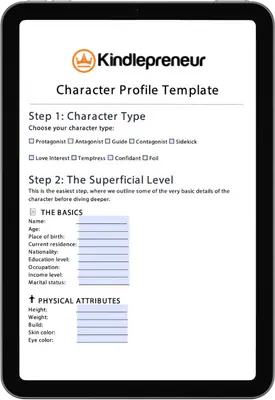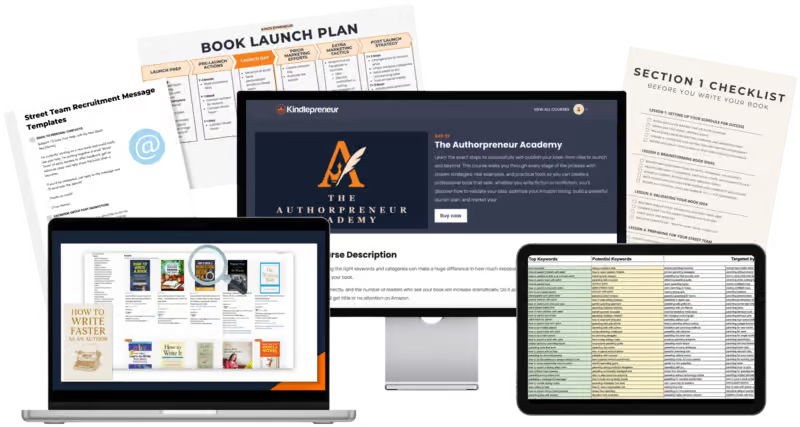Character development exercises are short, focused activities that help you practice writing believable, well-rounded characters.
They’re not meant to appear in your finished story. Instead, think of them as behind-the-scenes drills (little explorations that reveal who your characters really are and how they think, act, and change).
For many writers, creating authentic characters can be one of the hardest parts of storytelling.
That’s why we’ve gathered 17 powerful character development exercises to help you dig deeper and bring your fictional people to life.
Why Are Character Development Exercises Important?
So why bother with character development exercises at all?
It’s a fair question, especially for writers who prefer to dive right in and let their characters reveal themselves as the story unfolds.
But here’s the truth: spending a little time up front can save you a lot of rewriting later.
Working through a few focused exercises helps you:
- Understand your character’s emotions and motivations
- Practice writing in their unique voice and point of view
- Discover what makes them stand out from others in your story
- Build fuller, more dynamic characters
- Strengthen the relationships between characters and their world
- Get deliberate practice creating complex, well-written people on the page
In short, character development exercises give you the clarity and confidence to write believable characters from the start, not after five rounds of revision.
Of course, if you’re a pantser who loves discovering characters as you go, you might skip most of these. But even then, having a few go-to exercises in your writer’s toolkit can make the discovery process smoother and more rewarding.
So with that in mind, here are 17 of the best character development exercises to help you write richer, more authentic characters.
Exercise #1: Write a FULL Description
When it comes to writing characters, most of us focus on the facial features, things like hair color, eye color, etc.
A great way to begin getting to know your character is to do a full description of them. In a book, we might not do this to the extent you might in a creative writing exercise, which is why it’s good to practice here.
Here are some things to consider:
- Skin/hair/eye color
- Do they have any warts or moles?
- What is their hair style?
- What is their build?
- Do they have any scars, tattoos, etc.
- What is their general complexion. Is their skin smooth and silky, rough and calloused, or even bruised and battered?
- What default facial expression do they have?
- What does he/she smell like?
Exercise #2: Play Dress Up
What we choose to wear says a lot about a person. Someone wearing an extravagant French-style outfit from the 18th century will give you a completely different impression than a cut business suit from the 21st century.
The problem is that most authors, when they’re writing about their characters, often forget to add a lot of detail about the clothes they are wearing. It’s easy to see these things in your mind and forget that your readers don’t see what you see. They see what you write.
One way to help overcome this oversight is to continue the exercise above, but focus on clothing.
And don’t just focus on any one type, because your protagonist will most likely use several types of clothing throughout the course of your novel. Here are just some examples:
- Travel clothing
- Fine wear
- Sleep wear
- Clothes for a night on the town
- Clothes for wilderness survival
- Combat wear
Exercise #3: Write a Description Scene Through the Character’s Eyes
Ideally, every character should experience the same thing differently, depending on their background, their wants and desires, and their tastes.
Additionally, great prose is often written from the perspective of the character making the observation.
For example, let’s say you have two people, one who has grown up in a desert their whole life, where water is scarce, and the other who grew up in a place where water was plentiful.
Imagine these two people on a hot day, observing a third person splashing water on their face. If you’re writing from the first character’s perspective, you could describe this as “and the man took a handful of water and wasted it on his face.” The second person might describe it this way, “I watched as the man poured the cool liquid and splashed it all over his face. I wish I were him right now.”
Do you see the difference there? In one, the character sees using water in one way as a waste, and for the other, it’s something to be sought after.
Exercise #4: Practice Showing Emotion
We’ve all heard the adage to “show, don’t tell,” but what does this really look like for most characters?
This is something that really only comes with practice. Once you’ve done it enough times, you’ll recognize instances where you’re saying things like “he felt hungry,” and can replace them with something like “He winced and put a hand to his stomach as it growled, and he swallowed hard.”
Character emotion is one of these areas where showing rather than telling can really enhance your novel.
Exercise #5: Write a “Slice of Life” Episode
There are a lot of scenes in a book, and most of them have a purpose. That said, there are many scenes that probably occur in that character’s life, but that we don’t talk about because they’re not important for the story.
However, you as the author should have an idea of what happens in these less important moments.
Some examples of a “slice of life” episode might include:
- Having dinner with family
- Going to the bathroom
- The morning routine
- A conversation with a co-worker
- Late-night conversations with a spouse
- Cooking a meal
- Going on vacation
- Playing with their kids
- Coming home a little too drunk
- Visiting a museum
Exercise #6: Write Other People Gossiping About Your Character
Very often, we learn more from others about ourselves that we might not have known on our own. Others can provide unique perspectives, and in some cases expose huge biases (on both sides).
For example, a proud character might not realize that he/she is proud, but it’s easy for an outside observer to spot this.
Exercise #7: Write a Progression Short Story
In real life, people change a lot, and characters should change in stories too (most of the time).
A great way to show this is to write a short story that examines the character at different parts of her/his life. You can focus on key moments in their life, but you could also just follow exercise #5 and focus on a few more everyday events.
The purpose of this exercise is to show how that person may have changed. Do they view the world differently as a working adult, vs as a teenager? A child? An elderly person?
What about before or after experiencing some kind of trauma?
Exercise #8: Draw the Character
I’ll be honest, I’m not an artist. But I am a visual person, and getting some solid visuals of the character can be a huge boost in helping me understand them.
If you’re like me and really have no design skills, then finding a few photos is fine.
I’d recommend several photos though, since one might not be enough. You could have some for their face and general appearance, one for their clothes and how they look, etc.
If you know a program like Photoshop, you could even crop these together to get an even better sense of what you character looks like.
This is a great exercise for understanding the feel of a character, which is often harder to put into words.
Exercise #9: Create a Character Profile
Imagine you work for the FBI, and you have to draft up a dossier about your character. What might that look like?
Fortunately, we’ve done a whole article about this topic, so you should definitely check that out, and also don’t forget to pick up our character profile template, which can easily help you through this process.
If you want a thorough process to identify the character’s appearance, personality, background, and more, this is the way to go.
The best aspects to focus on are the flaws, motivations, and fears of your character. What prompts them to action? Understanding these things will help you get at the core of your character’s personality traits.
Exercise #10: Conduct a Character Interview
Imagine you sat in a darkened room, across the table from you is your character. You can ask them anything, they won’t be offended, and they will understand the question.
What do you ask them about?
Writing a character interview is almost like writing yourself into a short story where you get to personally meet your character and ask them questions.
This is huge for helping you understand the character’s voice, but also a good strategy for building solid character backstory and character traits.
To help, we’ve already assembled over 200 character development questions that can aid you in this process.
Exercise #11: Play the “Why” Game
This goes along with the idea of an interview, but sometimes in order to dig really deep into the motivations of your character, you’ve got to ask why.
Is your character aggressive? Ask them why.
From there you might find out that his mother shouted at him as a kid, and he saw his parents fight a lot. Ask why.
You might learn that his father had a drinking problem and it meant that his mother took it out on him. Ask why.
From there, it might come out that his father had lost a lot of money in a business deal, leading him to turn to drink.
I hope you get the idea. The more you ask why, the more you’ll dig deeper into your character’s past, and the better you will understand them.
Exercise #12: Create a Character Based on Someone You Know
This can be a little dangerous, because to be honest, most of the people we know are not that interesting. And we also want to avoid lawsuits for defamation if the comparison is too obvious.
That said, the people we know can be a huge inspiration to pick and choose ideas to incorporate into your characters.
For example, my own father and uncle have a really fun way of talking to each other. They’re always ribbing on each other and calling eachother weird, made-up names. You can tell that they love each other, but it’s an uncommon way of showing it.
This might make a good relationship between two people in a book.
Exercise #13: Imagine What Happens Before and After the Novel
The writer is mostly concerned with what happens during the plot of her novel. But if written well, a character will feel like they exist long before and long after the pages of the book.
So it’s a good idea to try dreaming up what happens to these characters in that time.
It can be dramatic, or it can be mundane. Impactful, or ordinary. It doesn’t matter much. All that matters is that you have a past and future in mind for that character (unless you plan to kill them off of course).
And who knows, you might even come up with some good ideas for other books involving those characters.
Exercise #14: Put Them in Horrible Situations (Muahahahahah)
I’ve heard it said that you should basically put your characters through hell in a story, and never let up.
While this is good advice, it’s not always practical. That said, putting your characters through the meat-grinder is a great way to learn how they react to conflict.
These scenarios don’t have to be trials you will actually use in your novel. These are just different ways to put your character in pain and see how they react (I know I sound like a very unethical scientist, don't @ me).
Here are some possibilities:
- The loss of a loved one
- A diagnosis of cancer
- The loss of a limb
- Getting tortured
- Breaking up with the love of their life
- Losing everything they own
- Being betrayed by a friend
Exercise #15: Create a Timeline
Sometimes it’s hard to keep every part of a character’s life straight. That’s where a timeline can be helpful.
A timeline is a simple list of events in the character’s life, though they can get more complex and interesting, and you can even put some design skills to work if you want.
But timelines only have to be a simple list of events. They can include events from before their birth to their death, or they can be focused on a specific period of their life.
It will depend on the character and the story you will want to tell.
Exercise #16: Do a Little Fan-fiction
When we’re writing a story, we might not have a full grasp on it yet, and that’s where writing fan fiction can help.
Imagine your character interacting with characters from a story you already know? Imagine the ultimate crossover between your story and your favorite franchise.
For example, what Hogwarts house would your character belong in? What might it look like when he/she is sorted and interacts with other characters in that house or other characters from the Harry Potter books.
It’s a great way to lean on characters you already know, to help unveil more about the characters you’re trying to discover.
Exercise #17: Use Character Writing Prompts
There are a bunch of character-related creative writing prompts out there, and many of them can be quite helpful in getting your brain to think outside of the box.
In theory, we could have a list much longer than 17 if we wanted to include more of these prompts, but that would end up being too much.
Instead, I recommend this post, or checking out our list of character questions to give you ideas.
Final Thoughts on Character Development Exercises
If you’ve made it this far — well done.
Feeling a little overwhelmed? Don’t be. This list is a collection of ideas and prompts you can mix, match, or adapt to fit your own creative process.
As you work through these character development exercises, you’ll not only learn more about your characters. You’ll grow as a writer too. Each exercise helps you write with greater depth, empathy, and confidence, leading to stronger, more dynamic characters on the page.
Try a few, see what works, and keep refining your approach. Your characters (and readers) will thank you for it.







